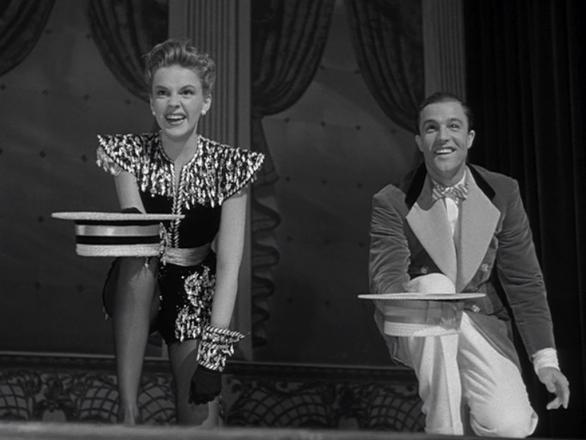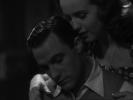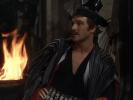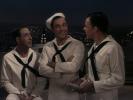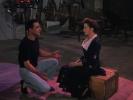Reviews
Busby Berkeley
USA, 1942
Credits
Review by Victoria Large
Posted on 20 August 2012
Source Warner Bros. DVD
Categories Gene Kelly
Many classic movie fans remember For Me and My Gal because of its significance as a Judy Garland picture: it provided the actress, then twenty years old, with a deliberately grown-up role, one that would help her transition into adult stardom. She proves more than up to the challenge. Garland shines as Jo Hayden, a young vaudevillian caught up in a love triangle just as the United States is on the brink of entering World War I. Your heart breaks when her large, dark eyes spill over with tears, and it kind of breaks and soars at the same time during her performance of “After You’ve Gone,” an old pop standard that somehow feels like it was written just for her.
Yet while it’s Garland’s name that’s featured above the film’s title card - and she’s more or less flawless throughout - For Me and My Gal really meant the most to her co-star Gene Kelly, who made his Hollywood debut here. Getting a comparatively late start in movies (he was thirty when this film was released, while Garland was singing “You Made Me Love You” onscreen at fourteen and taking home an Oscar a few years later), Kelly nevertheless makes a powerful first impression. His role is both substantial and complex, requiring him to lose and eventually regain audience sympathy as Harry Palmer, a dancer whose hunger for recognition drives him to selfishness.
The initial conflict in For Me and My Gal is pretty standard backstage musical stuff. Garland’s Jo leaves her steady and good-natured musical partner Jimmy Metcalf after falling for Kelly’s more roguish Harry. But the tension there is mostly preempted by the fact that Jimmy happens to be a really swell guy who understands and accepts Jo’s decision to be with Harry. So the focus shifts instead to Harry’s poisonous ambition, represented by his obsession with playing New York City’s Palace Theatre. When Jo and Harry finally do get that dream booking, however, Harry’s draft number comes up, and - spoiler alert - he takes the extreme measure of smashing his hand in a heavy trunk in the hopes of securing a temporary reprieve from his military service.
Let’s pause here a moment and reflect on the fact that in his Hollywood debut, Gene Kelly played a guy who resorts to self-mutilation in order to avoid being sent into the trenches of one of the most horrific conflicts in human history. I don’t want to belabor a point that has been made before, but one of the most interesting elements of Kelly’s star persona is the tension that exists between his sunny charm - the infectious grin, the buoyant dancing - and his harder edges, the fact that he could imbue his characters with authentic demons. This tension is something that would carry through Kelly’s career to varying degrees, becoming a key part of one of his last and best films for MGM, 1955’s It’s Always Fair Weather. There’s something to be said for this uneasy duality, and For Me and My Gal’s Harry Palmer is an intriguingly uncommon figure: an all-singing, all-dancing antihero.
Released in 1942 while the United States was engaged in the Second World War, For Me and My Gal predictably offers Harry a shot at redemption when he finds a way to serve his country in combat despite his self-inflicted injury. The film suffers no shortage of patriotism, seeking to stoke the audience’s wartime resolve with a series of nostalgic WWI-era numbers (Garland sings “It’s a Long Way to Tipperary” and “How Ya Gonna Keep “Em Down on the Farm?” in military garb) and concluding with a message reminding the audience to purchase war bonds. The flag-waving third act can be a bit difficult for modern audiences to swallow, and it has detracted from my own enjoyment of the film in the past. However, upon my most recent rewatch, perhaps primed by my previous viewings, I was less struck by the picture’s propagandistic impulses than by its capacity for forgiveness. As the infinitely empathetic Jimmy, George Murphy allows that Harry’s attempt to delay his military service is not only pardonable but understandable, the result of Harry’s love for his profession—as well as, of course, his love for Jo.
And indeed, even if the film’s finale is tough to take, For Me and My Gal is worth the watch for the extraordinary chemistry between its romantic leads. I may as well admit that Kelly and Garland, who ultimately appeared together in three films, are my favorite pairing of musical stars, two titanic talents who are fabulous on their own and better together. (Their offscreen friendship is fairly well known. She helped him get his part in For Me and My Gal and proceeded to show him the ropes of acting for the screen rather than the stage. He never forgot it.) They share many great moments in this first film, including the grin-inducing dance number “Ballin’ the Jack” and a soft-focus first kiss. But the real treat is their performance of the title song, a number that bears the Kelly hallmark of taking place in an ordinary setting, in this case a coffee shop.
Garland does most of the singing (though the tune did give cinemagoers their first taste of Kelly’s light, high tenor) but when they dance, they match each other step-for-step. And what’s more, they seem fully engaged with one another, smiling into each other’s eyes at least as often as they beam at their unseen matinee audience. It’s their quintessential duet, and a perfect illustration of how well matched they are onscreen.
As actors, the pair always seem to push each other in the right directions, particularly in this film, where Kelly’s audacity brings out the toughness beneath Garland’s tremulous exterior and her sweetness lays bare his vulnerability. In that sense, For Me and My Gal succeeds at two of the most important things that it sets out to do: it gives Garland a chance to grow up, and Kelly a chance to give a multifaceted performance at a crucial moment in his career. I’m grateful on both counts.
More Gene Kelly
We don’t do comments anymore, but you may contact us here or find us on Twitter or Facebook.



